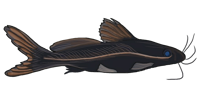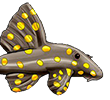| Scientific Name | Synodontis batensoda Rüppell, 1832 |
| Common Name | Giant Upside Down Catfish |
| Type Locality | Nile River, Egypt. |
| Synonym(s) | Brachysynodontis batensoda, Synodontes ruppelli, Synodontis melanogaster |
| Pronunciation | sin oh don tiss - bat en soda |
| Etymology | According to Cuvier, Synodontis is an "ancient name for an undetermined fish from the Nile". It is not derived, as often reported, from syn-, together and odous, tooth, presumed etymology of the lizardfish genus Synodus and refers to the closely-spaced lower jaw teeth of both genera. |
| Size | 500mm or 19.7" SL. Find near, nearer or same sized spp. |
| Identification | All species in the genus Synodontis have a hardened head cap that has attached a process (humeral process) which is situated behind the gill opening and pointed towards the posterior. The dorsal fin and pectoral fins have a hardened first ray which is serrated. Caudal fin is always forked. There is one pair of maxillary barbels, sometimes having membranes and occasionally branched. The two pairs of mandibular barbels are often branched and can have nodes attached. The cone-shaped teeth in the upper jaw are short. S-shaped and movable in the lower jaw. These fish produce audible sounds when disturbed rubbing the base of the pectoral spine against the pectoral girdle. Body is short and deep. Eyes are large. Coloration is gray-black tinged with brown, with a faint network of dark black spots. Maxillary barbels have membranes, though these are not as wide as in S. membranaceus. There is continuing debate as to whether this fish belongs in Synodontis or within a separate monotypic genus Brachysynodontis. Over the years, its placement has moved back and forth between the two genera. The most recent osteological study (Pinton & Otera, 2010) placed this species within Synodontis, observing that there are no reliable osteological traits that warrant breaking Brachysynodontis apart from Synodontis. That said, there are observable differences in this species relative to other Synodontis. The major differences are: (1) it has 39-42 gill rakers (for filter-feeding of plankton), a much larger number than the 7-33 typical of other Synodontis, and (2) its adipose fin is large and contiguous with the dorsal fin. Like a small number of other Synodontis species (e.g., S. nigriventris), S. batensoda almost always swim upside down. It is believed that the species' large adipose fin and compressed body help it to maintain stability while inverted. Some sources claim it grows as large as 270 mm. [Fishbase lists 500mm TL]. |
| Sexing | First lay the fish in your hand with its head toward your palm and the tail toward your fingers. Hold the dorsal spine between your middle and ring finger so the fish is belly up and you won't get stuck (Which by the way, hurts like crazy!). The genital pore is in a small furrow of tissue (in healthy fish) and will be obstructed by the pelvic fins. Pull down on the tail gently to arch the fishes spine and the pelvic fins will stand and the furrow open to display the genital pore and the anus of the fish. The male has a somewhat ridged genital papillae on which the spermatoduct is on the back side, facing the tail fin. A gravid female will also show an extended papillae but the oviduct is on the ventral side of the papillae (And may also show a little redness if really gravid). A thin or emaciated female will have just two pink pores, the oviduct and the anus. |
| Distribution | Africa: Nile, Chad, Niger (including the Bénoué), Senegal and Gambia basins. African Waters, Nile (click on these areas to find other species found there) African Waters, Nigeria Waters, Niger (click on these areas to find other species found there) African Waters, Chad (click on these areas to find other species found there) African Waters, Sénégal (click on these areas to find other species found there) African Waters, Gambia (click on these areas to find other species found there) Login to view the map. |
| IUCN Red List Category | Least Concern , range map and more is available on the IUCN species page. Last assessed 2019. |
| pH | 6.4 - 7.8 |
| Temperature | 24.0-28.0°C or 75.2-82.4°F (Show species within this range) |
| Other Parameters | In its natural habitat, occurs in slow moving pools and marshes bordering large rivers. |
| Feeding | Omnivore. In nature, feeds on plankton, algae and detritus, and may also feed on surface insects, chironomid larvae, benthic crustaceans and molluscs. In the aquarium, will readily accept flakes, but appreciates the occasional treat of brine shrimp, bloodworm, etc. User data. |
| Furniture | Since this fish both rests and swims in an inverted position, driftwood with horizontal branches and broad leaf plants like Anubias spp. are to be recommended. |
| Compatibility | A peaceful species that poses no threat to even small fish. May be harassed by more aggressive Synodontis species. |
| Breeding | Not reported in the aquarium. |
| Breeding Reports | There is no breeding report. |
| Reference | Fortsetzung der Beschreibung und Abbildung meherer neuer Fische, pp 6, Pl. 3 (fig. 2). |
| Registered Keepers | There are 20 registered keepers, view all "my cats" data. |
| Wishlists | Love this species? Click the heart to add it to your wish list. There is no wish to keep this species. |
| Spotters | Spotted this species somewhere? Click the binoculars! There are 8 records of this fish being seen, view them all. |
| Forum BBCode | |
| Search for S. batensoda | |
| Look up S. batensoda on AquaticRepublic.com | |
 | Look up S. batensoda on Fishbase |
 | Look up S. batensoda on Encyclopedia of Life |
 | Look up S. batensoda on Global Biodiversity Information Facility |
| LFS label creator ARN ref:1.13.29.780 | |
| Last Update | 2025 Jan 02 01:37 (species record created: 2002 Jan 14 00:00) |





/siluriformes/mochokidae/synodontis/batensoda/1.jpg)
/siluriformes/mochokidae/synodontis/batensoda/2.jpg)
/siluriformes/mochokidae/synodontis/batensoda/3.jpg)
/siluriformes/mochokidae/synodontis/batensoda/4.jpg)
/siluriformes/mochokidae/synodontis/batensoda/5.jpg)
/siluriformes/mochokidae/synodontis/batensoda/6.jpg)
/siluriformes/mochokidae/synodontis/batensoda/7.jpg)
/siluriformes/mochokidae/synodontis/batensoda/8.jpg)
/siluriformes/mochokidae/synodontis/batensoda/9.jpg)
/siluriformes/mochokidae/synodontis/batensoda/10.jpg)
/siluriformes/mochokidae/synodontis/batensoda/11.jpg)
/siluriformes/mochokidae/synodontis/batensoda/12.jpg)
/siluriformes/mochokidae/synodontis/batensoda/13.jpg)